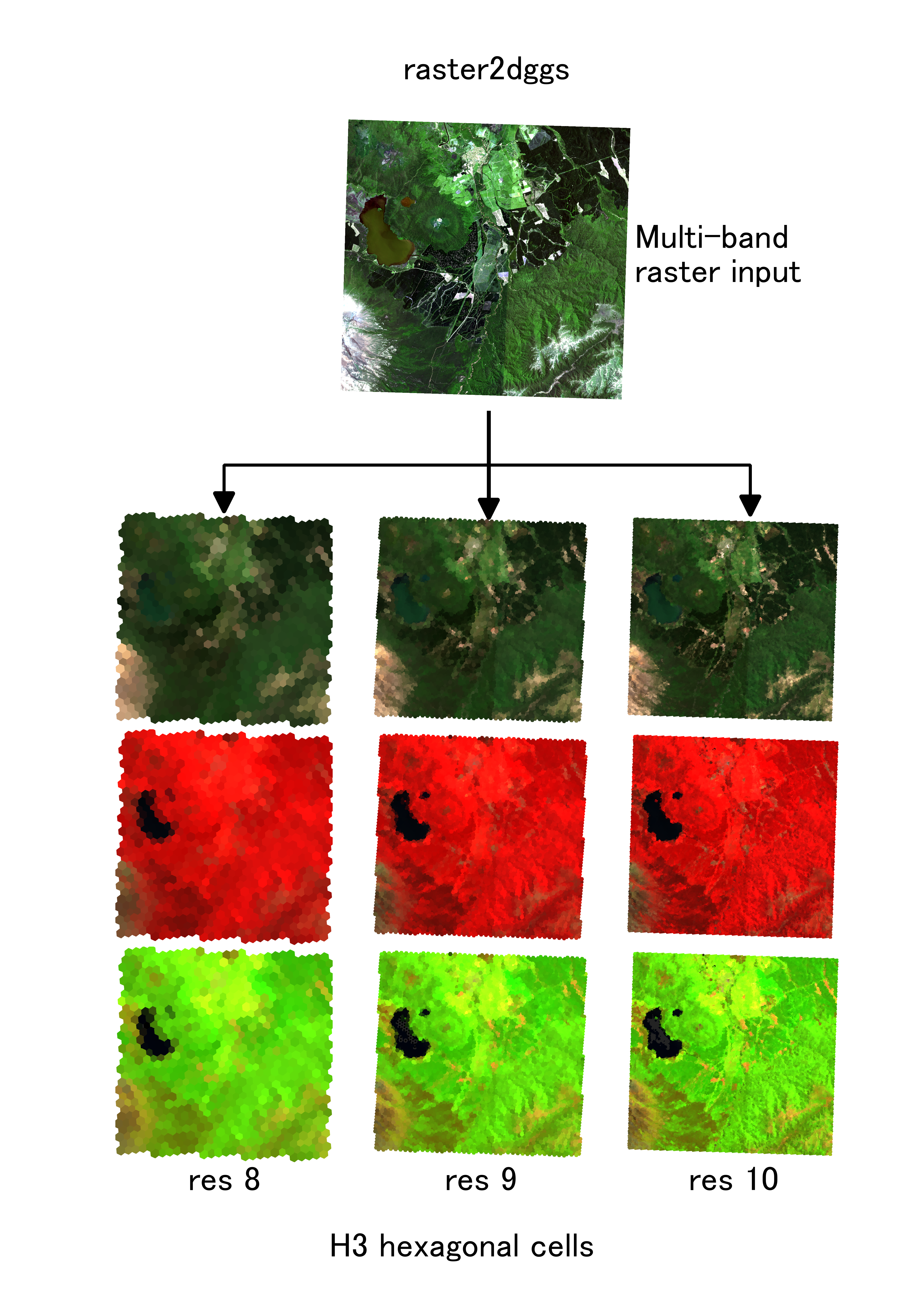Python-based CLI tool to index raster files to DGGS in parallel, writing out to Parquet.
Currently only supports H3 DGGS, and probably has other limitations since it has been developed for a specific internal use case, though it is intended as a general-purpose abstraction. Contributions, suggestions, bug reports and strongly worded letters are all welcome.
pip install raster2dggs
raster2dggs h3 --help
Usage: raster2dggs h3 [OPTIONS] RASTER_INPUT OUTPUT_DIRECTORY
Ingest a raster image and index it to the H3 DGGS.
RASTER_INPUT is the path to input raster data; prepend with protocol like
s3:// or hdfs:// for remote data. OUTPUT_DIRECTORY should be a directory,
not a file, as it will be the write location for an Apache Parquet data
store, with partitions equivalent to parent cells of target cells at a fixed
offset. However, this can also be remote (use the appropriate prefix, e.g.
s3://).
Options:
-v, --verbosity LVL Either CRITICAL, ERROR, WARNING, INFO or
DEBUG [default: INFO]
-r, --resolution [0|1|2|3|4|5|6|7|8|9|10|11|12|13|14|15]
H3 resolution to index [required]
-pr, --parent_res [0|1|2|3|4|5|6|7|8|9|10|11|12|13|14|15]
H3 Parent resolution to index and aggregate
to. Defaults to resolution - 6
-u, --upscale INTEGER Upscaling factor, used to upsample input
data on the fly; useful when the raster
resolution is lower than the target DGGS
resolution. Default (1) applies no
upscaling. The resampling method controls
interpolation. [default: 1]
-c, --compression [snappy|gzip|zstd]
Name of the compression to use when writing
to Parquet. [default: snappy]
-t, --threads INTEGER Number of threads to use when running in
parallel. The default is determined based
dynamically as the total number of available
cores, minus one. [default: 7]
-a, --aggfunc [count|mean|sum|prod|std|var|min|max|median]
Numpy aggregate function to apply when
aggregating cell values after DGGS indexing,
in case of multiple pixels mapping to the
same DGGS cell. [default: mean]
-d, --decimals INTEGER Number of decimal places to round values
when aggregating. Use 0 for integer output.
[default: 1]
-o, --overwrite
--warp_mem_limit INTEGER Input raster may be warped to EPSG:4326 if
it is not already in this CRS. This setting
specifies the warp operation's memory limit
in MB. [default: 12000]
--resampling [nearest|bilinear|cubic|cubic_spline|lanczos|average|mode|gauss|max|min|med|q1|q3|sum|rms]
Input raster may be warped to EPSG:4326 if
it is not already in this CRS. Or, if the
upscale parameter is greater than 1, there
is a need to resample. This setting
specifies this resampling algorithm.
[default: average]
--version Show the version and exit.
--help Show this message and exit.
Output is in the Apache Parquet format, a directory with one file per partition. Partitions are based on parent cell IDs, with the parent resolution determined as an offset from the target DGGS resolution.
For a quick view of your output, you can read Apache Parquet with pandas, and then use h3-pandas and geopandas to convert this into a GeoPackage for visualisation in a desktop GIS, such as QGIS. The Apache Parquet output is indexed by the DGGS column, so it should be ready for association with other data prepared in the same DGGS.
>>> import pandas as pd
>>> import h3pandas
>>> o = pd.read_parquet('./tests/data/output/9/Sen2_Test')
>>> o
band B02 B03 B04 B05 B06 B07 B08 B8A B11 B12
h3_09
89bb0981003ffff 9 27 16 62 175 197 228 247 102 36
89bb0981007ffff 10 30 17 66 185 212 238 261 113 40
89bb098100bffff 10 26 15 60 169 190 228 241 103 37
89bb098100fffff 11 29 17 66 181 203 243 257 109 39
89bb0981013ffff 8 26 16 58 172 199 220 244 98 34
... ... ... ... ... ... ... ... ... ... ...
89bb0d6eea7ffff 10 18 15 41 106 120 140 146 102 47
89bb0d6eeabffff 12 19 15 39 95 107 125 131 84 39
89bb0d6eeafffff 12 21 17 43 101 115 134 141 111 51
89bb0d6eeb7ffff 10 20 14 45 120 137 160 165 111 48
89bb0d6eebbffff 15 28 20 56 146 166 198 202 108 47
[5656 rows x 10 columns]
>>> o.h3.h3_to_geo_boundary().to_file('~/Downloads/Sen2_Test_h3-9.gpkg', driver='GPKG')In brief, to get started:
- Install Poetry
- Install GDAL
- If you're on Windows,
pip install gdalmay be necessary before running the subsequent commands. - On Linux, install GDAL 3.6+ according to your platform-specific instructions, including development headers, i.e.
libgdal-dev.
- If you're on Windows,
- Create the virtual environment with
poetry init. This will install necessary dependencies. - Subsequently, the virtual environment can be re-activated with
poetry shell.
If you run poetry install, the CLI tool will be aliased so you can simply use raster2dggs rather than poetry run raster2dggs, which is the alternative if you do not poetry install.
Please run black . before committing.
Two sample files have been uploaded to an S3 bucket with s3:GetObject public permission.
s3://raster2dggs-test-data/Sen2_Test.tif(sample Sentinel 2 imagery, 10 bands, rectangular, Int16, LZW compression, ~10x10m pixels, 68.6 MB)s3://raster2dggs-test-data/TestDEM.tif(sample LiDAR-derived DEM, 1 band, irregular shape with null data, Float32, uncompressed, 10x10m pixels, 183.5 MB)
You may use these for testing. However you can also test with local files too, which will be faster.
raster2dggs h3 --resolution 11 -d 0 s3://raster2dggs-test-data/Sen2_Test.tif ./tests/data/output/11/Sen2_Testraster2dggs h3 --resolution 13 --compression zstd --resampling nearest -a median -d 1 -u 2 s3://raster2dggs-test-data/TestDEM.tif ./tests/data/output/13/TestDEM
@software{raster2dggs,
title={{raster2dggs}},
author={Ardo, James and Law, Richard},
url={https://github.com/manaakiwhenua/raster2dggs},
version={0.2.6},
date={2023-02-09}
}APA/Harvard
Ardo, J., & Law, R. (2023). raster2dggs (0.2.6) [Computer software]. https://github.com/manaakiwhenua/raster2dggs


